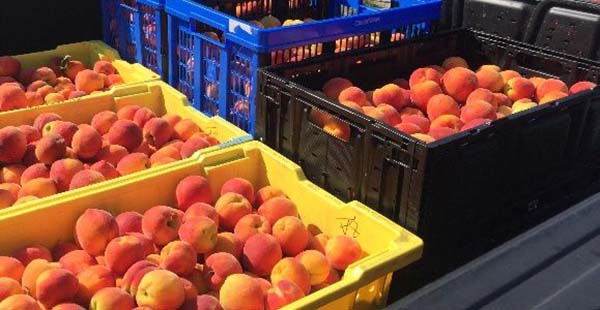Abstract
Peaches are a promising option for the Florida agricultural industry with plenty of revenue streams including fresh market, U-pick, and retail sales, as well as alternatives in the juicing and fermentation industries. This publication discusses a 2018 case study completed on a Florida peach cultivar. ‘UFSun’ were harvested, processed into juice, and analyzed for sugar content, juice yield, and general economic feasibility. UF/IFAS has bred peach cultivars that grow commercially in tropical and subtropical climates such as Florida’s and are harvest-ready two months before the rest of the United States, offering competitive advantages. Unfortunately, their small size renders them less profitable in fresh markets compared to larger non-Florida cultivars. Knowing the processing characteristics of Florida peaches provides valuable information for peach farmers who are considering using their peaches for juicing, fermentation, and similar purposes.
References
Abidi, W., S. Jimenez, M. A. Moreno, and Y. Gogorcena. 2011. “Evaluation of Antioxidant Compounds and Total Sugar Content in a Nectarine [Prunus persica (L.) Batsch] Progeny.” International Journal of Molecular Science 12 (10): 6919–6935. https://doi.org/10.3390/ijms12106919
Bates, R. P., J. R. Morris, and P. G. Crandall. 2001. “Tree Fruit: Apple, Pear, Peach, Plum, Apricot and Plums.” In Principles and Practices of Small- and Medium-scale Fruit Juice Processing. 150–169. Rome, Italy: Food & Agricultural Organization.
Chang, Y., A. Sarkhosh, J. Brecht, and P. Andersen. 2019. “Thinning Florida Peaches for Larger Fruit.” HS1324. Gainesville: University of Florida Institute of Food and Agricultural Sciences. https://edis.ifas.ufl.edu/hs1324
Crisosto, C. H., and G. Costa. 2008. “Preharvest Factors Affecting Peach Quality.” In The Peach: Botany, Production and Uses. Cambridge, MA: CAB International. 536–549.
Crisosto, C. H., and D. Valero. 2008. “Harvesting and Postharvest Handling of Peaches for the Fresh Market,” In The Peach: Botany, Production and Uses. Cambridge, MA: CAB International. 575–596.
Curtis, S. J. 2019. “An Assessment of the Processing, Fermentation, and Volatile Characteristics of Juice from ‘UFSun’ Peaches Grown on Thinned and Unthinned Trees.” Master’s thesis, University of Florida. https://ufdc.ufl.edu/UFE0056195/00001/pdf
Ferguson, J., P. Anderson, J. Chaparro, and J. Williamson. 2008. “Florida Subtropical Peaches: General Concepts and Cultivars Recommended for Grower Trials.” HS1125. Gainesville: University of Florida Institute of Food and Agricultural Sciences. https://journals.flvc.org/edis/article/download/117220/115336/170128
Freedonia Group. 2017. Fresh Produce: U.S. Retail Market Trends and Opportunities: Market Research Report. Packaged Facts. https://www.packagedfacts.com/Fresh-Produce-Trends-Opportunities-11000277/
Iezzoni, A. 2019. “Peach Fruit Texture.” Plant Breeding and Genomics. https://plant-breeding-genomics.extension.org/peach-fruit-texture/
Jayani, R. S., S. Saxena, and R. Gupta. 2005. “Microbial Pectinolytic Enzymes: A Review.” Process Biochemistry 40 (9): 2931–2944. https://doi.org/10.1016/j.procbio.2005.03.026
Kader, A. A. 2013. “Postharvest Technology of Horticultural Crops—An Overview from Farm to Fork.” Ethiopian Journal of Applied Science and Technologies. 1–8. https://ucanr.edu/sites/Postharvest_Technology_Center_/files/231724.pdf
Lurie, S., and C. H. Crisosto. 2005. “Chilling Injury in Peach and Nectarine.” Postharvest Biology and Technology 37 (3): 195–208. https://doi.org/10.1016/j.postharvbio.2005.04.012
Oliveira, M. A., M. Pintado, and D. P. F. Almeida. 2012. “Phytochemical Composition and Antioxidant Activity of Peach as Affected by Pasteurization and Storage Duration.” LWT – Food Science and Technology 49 (2): 202–207. https://doi.org/10.1016/j.lwt.2012.07.008
Olmstead, M. A., J. L. Gilbert, T. A. Colquhoun, D. G. Clark, R. Kluson, and H. R. Moskowitz. 2015. “In Pursuit of the Perfect Peach: Consumer-assisted Selection of Peach Fruit Traits.” HortScience 50 (8): 1202–1212. https://doi.org/10.21273/HORTSCI.50.8.1202
Petruzzi, L., D. Campanello, B. Speranza, M. R. Corbo,M. Sinigaglia, and A. Bevilacqua. 2017. “Thermal Treatments for Fruit and Vegetable Juices and Beverages: A Literature Overview.” Comprehensive Reviews in Food Science and Food Safety 16 (4): 668–691. https://doi.org/10.1111/1541-4337.12270.
Rumble, J. N., K. Harders, and K. Stofer. 2021. “Florida Peaches: A Perfect Snack.” AEC625. Gainesville: University of Florida Institute for Food and Agricultural Sciences. http://edis.ifas.ufl.edu/wc287
Rumble, J. N., and C. G. Roper. 2017. “Talking Local: Florida Consumers’ Fresh from Florida Perceptions: AEC516/WC181, Rev. 11/2017.” EDIS 2017 (4). https://doi.org/10.32473/edis-wc181-2017
Sarkhosh, A., M. Olmstead, J. Chaparro, P. Anderson, and J. Williamson. 2019. “Florida Peach and Nectarine Varieties.” CIR1159. Gainesville: University of Florida Institute of Food and Agricultural Sciences. http://edis.ifas.ufl.edu/mg374
Sarkhosh, A., M. Olmstead, J. Williamson, J. Chaparro, and J. Popenoe. 2019. “Alternative Opportunities for Small Farms: Peach and Nectarine Production Review.” RFAC018. Gainesville: University of Florida Institute for Food and Agricultural Sciences. https://edis.ifas.ufl.edu/ac018
United States Food and Drug Administration (FDA). 2019. “101.30 Percentage Juice Declaration for Foods Purporting to be Beverages that Contain Fruit or Vegetable Juice.” In Code of Federal Regulations Title 21, Vol. 2: 108–110. https://www.govinfo.gov/content/pkg/CFR-2019-title21-vol2/pdf/CFR-2019-title21-vol2.pdf

